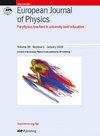在经典相互作用中能否忽略偶极子场中的狄拉克三角?
IF 0.8
4区 教育学
Q4 EDUCATION, SCIENTIFIC DISCIPLINES
引用次数: 0
摘要
在研究(或讲授)经典电磁学时,我们必然会涉及理想偶极子的电场及其对应磁场。仔细分析就会发现,为了保持一致性,每个场都必须包含一个与偶极子位置处的狄拉克三角函数成比例的项。然而,人们通常被告知不必担心这些项,因为经典相互作用总是涉及空间上分离的源,而狄拉克-德尔塔项只与量子力学有关,因为它们与量子力学中的重要现象直接相关。在这项研究中,我们提出并解决了一个纯经典的静电问题,在这个问题中,偶极子场中的狄拉克-德尔塔项是不可或缺的。该问题涉及计算带有球形空腔的导体与位于空腔中心的(理想)电偶极子之间的相互作用能。我们还求解了与之对应的磁场,用超导体代替导体,用磁偶极子代替电偶极子。本文章由计算机程序翻译,如有差异,请以英文原文为准。
Can the Dirac deltas in dipole fields be ignored in classical interactions?
When studying (or teaching) classical electromagnetism, one is bound to deal with the electric field of an ideal electric dipole, as well as its magnetic counterpart. A careful analysis then reveals that each of those fields must include, for consistency, a term proportional to a Dirac delta function localized at the position of the dipole. However, one is usually told not to worry about those terms since, as classical interactions always involve sources which are spatially separated, the Dirac-delta terms are only relevant for quantum mechanics, where they are directly related to important phenomena. In this work, we pose and solve a purely classical problem in electrostatics in which the Dirac-delta terms in the dipole fields are indispensable. It involves the computation of the interaction energy between a conductor with a spherical cavity and an (ideal) electric dipole located at the center of that cavity. We also solve its magnetic counterpart, replacing the conductor with a superconductor and the electric dipole with a magnetic one.
求助全文
通过发布文献求助,成功后即可免费获取论文全文。
去求助
来源期刊

European Journal of Physics
物理-物理:综合
CiteScore
1.70
自引率
28.60%
发文量
128
审稿时长
3-8 weeks
期刊介绍:
European Journal of Physics is a journal of the European Physical Society and its primary mission is to assist in maintaining and improving the standard of taught physics in universities and other institutes of higher education.
Authors submitting articles must indicate the usefulness of their material to physics education and make clear the level of readership (undergraduate or graduate) for which the article is intended. Submissions that omit this information or which, in the publisher''s opinion, do not contribute to the above mission will not be considered for publication.
To this end, we welcome articles that provide original insights and aim to enhance learning in one or more areas of physics. They should normally include at least one of the following:
Explanations of how contemporary research can inform the understanding of physics at university level: for example, a survey of a research field at a level accessible to students, explaining how it illustrates some general principles.
Original insights into the derivation of results. These should be of some general interest, consisting of more than corrections to textbooks.
Descriptions of novel laboratory exercises illustrating new techniques of general interest. Those based on relatively inexpensive equipment are especially welcome.
Articles of a scholarly or reflective nature that are aimed to be of interest to, and at a level appropriate for, physics students or recent graduates.
Descriptions of successful and original student projects, experimental, theoretical or computational.
Discussions of the history, philosophy and epistemology of physics, at a level accessible to physics students and teachers.
Reports of new developments in physics curricula and the techniques for teaching physics.
Physics Education Research reports: articles that provide original experimental and/or theoretical research contributions that directly relate to the teaching and learning of university-level physics.
 求助内容:
求助内容: 应助结果提醒方式:
应助结果提醒方式:


